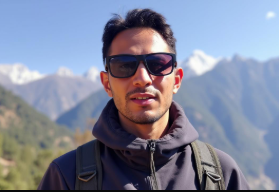Salleri to Everest Base Camp Trek
Trip Type
Trekking In Nepal
Accomodation
Tea House
Destination
Nepal
Start Point
Kathmandu
Region
Everest Region
Duration
14 Days
Salleri to Everest Base Camp Trek is a unique route to EBC. Unlike the traditional way to EBC like the flight from Kathmandu to Lukla. This Trek starts with a long scenic drive to Salleri which is a district headquarter of Solukhumbu. This trek route passes through pine and alpine forest, remote villages. One of the best things about this trek is it keeps you physically fit and gives sufficient time to get well acclimatized before heading to Everest Base Camp.
Seasonal Information:
Weather is a critical factor that influences the experience of trekkers. Weather varies during different seasons in EBC. For Spring (March-May), You can experience clear skies. At day time, the temperature is 10°C to 15°C at lower altitudes and at night time, temperature can drop to below freezing.You can see clear mountain views. For Autumn( September-November), you can experience dry and stable weather conditions. At that time, the temperature is 12°c to 20°c at lower altitudes. The night time temperature is -10°C to -15°C (14°F to 5°F). For Winter(December-February), the weather is extremely cold at high altitudes. In day time, the temperature is 0°C to 5°C and in night time, the temperature drops down. For Monsoon(June-August), continual rainfall below 3000 m. You experience slippery trails and limited mountain views. Therefore, plan your trek during spring or autumn for the best experience.
Cultural and Natural Insights:
-
In this region, you can explore the Sherpa culture and tradition. The way they live their simple life and their history of mountaineering. You can visit the most spiritual centers in the region, the Tengboche Monastery and Taksindu Monastery.
-
You can explore Buddhist practices like observing prayer flags, mani stones and stupas along the route. If you like, you can attend the morning prayers in the monasteries.
-
Flora and Fauna are other main things in the Solukhumbu National Park. You can explore wildlife like the Himalayan monal and musk deer. Likewise you can explore rhododendron forest, pine trees.
-
There are geographical features and you can understand the glacial valleys, rivers, majestic summits that define the Everest region.
-
The route passes through remote villages like Salleri, Taksindu, Nunthala, Kharikhola and Paiya.
Preparation Guide:
-
For physical fitness cardiovascular exercise is needed. You need to do strength training to walk for many hours. You need hike practice.
-
Packing list :
-
For clothing you need layered clothes, an insulated jacket, waterproof shell, trekking pants, gloves, ha, gaiters.
-
For footwear you need high quality trekking boots that have to be waterproof.
-
For Gear you need sleeping bag, trekking poles and headlamp
-
For your essentials you need sunscreen, lip balm, and a water purification tablet.
-
You need Sagarmatha National Park Permit and Khumbu Pasang Lhamu Rural Municipality Permit.
Sustainability and Responsibility:
-
Environmental Responsibility:
-
Avoid using non- degradable things. Stop using plastic bottles.
-
Avoid disturbing wildlife and also ask consent to the locals before taking photos.
-
You should support eco-friendly Lodges which are sustainable.
-
Cultural Aspects:
-
You should respect the culture of locals
-
Consider buying products from the local economy to uplift their economy.
-
Sustainable Trekking:
-
Hiring Guide and Porter for ethical adventure experience.
-
Avoid using single use plastics.
Modern Trekkers Expectation:
-
Internet access as wifi is available at teahouses.
-
Comfortable accommodation due to upgraded teahouses and hygiene facilities.
-
Available expanded menu of options including pizza, pancakes, and vegetarian dishes.
-
Sustainable and ethical practices as sustainable practice of waste management and using renewable energy.
-
Services of health support for high altitude related issues by Himalayan Rescue Association in Pheriche.
-
Customizable trekking experience for solo travellers or groups for more fun in adventure.
Short Treks You might like:
Highlights of the Salleri to Everest Base Camp Trek
Highlights:
-
Scenic drive from Kathmandu to Salleri.
-
It has more acclimatization days to reduce altitude sickness.
-
You can explore villages like Salleri, Taksindu, Nunthala, Kharikhola and Paiya where Sherpa and Rai communities live.
-
Hike through rhododendron forest, suspension bridge, deep valleys, and glaciers.
-
You can witness the great Khumbu glacier and icefall.
-
Option of trekking or you can take a scenic flight from Lukla to kathmandu.
-
You can witness the sunrise from Kala Pathar and views of Mount Everest along with other himalayas.
Short Itinerary ( 14 days )
Arrival in Kathmandu and scenic drive to Salleri through hills, rivers, villages. Your trek starts to Taksindu from Salleri through sherpa villages and rhododendron forests. Distance: 266 km(drive), 8 km(trek), walking hours: 8-10, altitude gain: 1570 m.
Your trek starts passing through villages like Nunthala, Kharikhola. We’ll cross suspension bridges. And you get explore authentic sherpa culture. Distance: 16km, walking hours: 6-7, altitude loss: 230m
Starts our trek to Phakding. You can witness the first glimpse of Mount Everest. Join the Epic Everest Base Camp trail. Distance: 14km, walking hours:5-6 hrs, altitude loss: 120m
Trek to Namche Bazar crossing several suspension bridges that include the iconic Hillary bridge and stay overnight at a guest house. Distance: 10-12 km, Walking Hours: 5-6 hr trek, Altitude Gain: 830 m
We’ll hike to the hotel Everest view (3,8880 m) for the stunning view of mount everest and return. Distance:5-6 km, Walking Hours: 2-3 hrs, Altitude Gain: 440m
Following the route, we’ll trek to Tengboche(3,860 m), to visit Tengboche Monastery, which is one of the most crucial manastries in the region that takes 5-6 hrs of trek and stay overnight in the guesthouse. Distance: 10-12 km, Walking Hours: 5-6 hr, Altitude Gain: 420 m
Now descending to the Imja Khola river, then ascending to Dingboche that takes 5-6 hrs of trek. Enjoy the views of Ama Dablam, Island Peak, and other towering peaks.Distance: 10-12 km, Walking Hours: 5-6 hr, Altitude Gain: 550 m
Acclimatization day continues at Dingboche. You can hike to Nangkartshang peak for a panoramic view of mountains.
Stop at the Thukla Pass memorial site honoring the climbers who lost their lives on Everest. Trekking time would be 5-6 hrs. Distance: 7-8 km, Walking Hour: 5-6 hr, Altitude Gain: 500 m.
We'll trek to reach Everest Base Camp(5,364 m) passing along Khumbu Glacier and celebrating the achievement, enjoying the views of icefall and towering peaks and then returning to Gorak Shep for the night stay. Distance: 8-10 km, Walking Hours: 5-6 hr, Altitude Gain: 454 m
A hike to kala Pathar to witness the stunning sunrise over mount everest, and descend to Periche via Gorak shep and Lobuche.Stay overnight at a guesthouse in Periche. It takes us 7-8 hrs of trek time. Distance: 7-8 km, Walking Hours: 7-8 hr, Altitude loss: 1,305 m
Return to Namche Bazaar and stay overnight. Distance: 13-15 km, Walking Hours:7-8 km, Altitude Loss: 800 m.
Again trek to Lukla through forests and cross suspension bridge. The trekking time would be 7-8 hrs and stay overnight in Lukla. Distance: 10-12 km, Walking Hours: 7-8 hr, Altitude Loss: 600-700 m.
Morning flight to Kathmandu, check in to the hotel and enjoy the rest of the day or explore the city. Then Transfer to the International Airport for your departure.
Cost Includes
Included:
-
Transportation Cost
-
Accommodation Cost
-
Basic meals but nutritious
-
Guide and porters service
-
Medical service
-
Government taxes and service
-
Equipment
-
Cost of Permit
Cost Excludes
Excluded:
-
International flights
-
Visa fees for Nepal
-
Meals in Kathmandu (actually not included)
-
Your personal trekking gears
-
Your personal expense
-
Tips for guide or porters
-
Cost of Hotshowers and Charging
-
Cost of additional services


.png)

